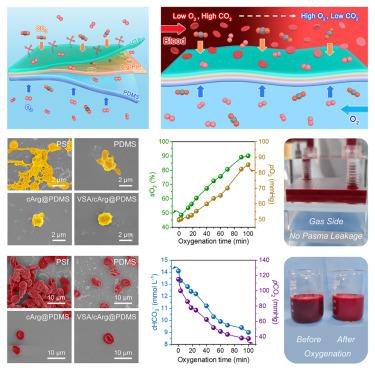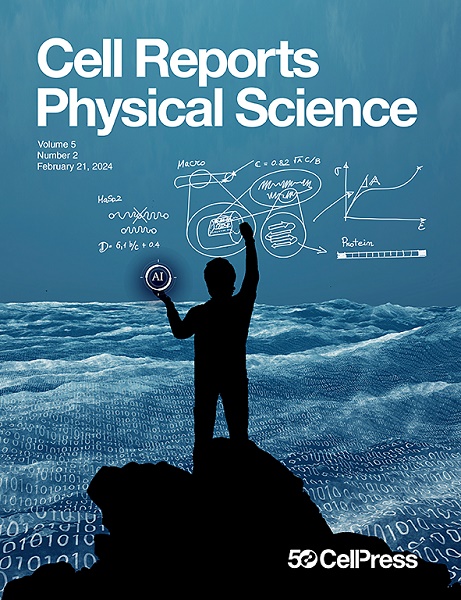用于体外膜氧合的先进氨基酸仿生Janus膜
IF 7.9
2区 综合性期刊
Q1 CHEMISTRY, MULTIDISCIPLINARY
引用次数: 0
摘要
体外膜氧合(Extracorporeal membrane oxygenation, ECMO)是一种提供体外呼吸和循环的生命支持系统。目前的氧合膜仍面临等离子体泄漏、O2和CO2气体交换效率低、生物相容性差等挑战。在这里,我们描述了仿生Janus膜的设计和实现,以模拟肺泡血气屏障的结构特征。通过疏水聚二甲基硅氧烷层、亲水性氨基酸层和磺酸盐接枝层序组装而成的不对称结构,具有防止等离子体泄漏、提高气体交换性能和维持生物相容性等功能。重要的是,该膜可以提供有效的血液氧合,O2和CO2的传递速率分别为~ 54和~ 131 mL m−2 min−1。这项工作表明,巧妙设计的Janus结构提供了所需的氧化膜的综合性能,并为开发更先进的氧化膜提供了有价值的指导。本文章由计算机程序翻译,如有差异,请以英文原文为准。

Advanced amino acid-based biomimetic Janus membrane for extracorporeal membrane oxygenation
Extracorporeal membrane oxygenation (ECMO) is a life support system that provides extracorporeal respiration and circulation. Current oxygenation membranes still face the challenges of plasma leakage, low gas exchange efficiency of O2 and CO2, and poor biocompatibility. Here, we describe the design and realization of a biomimetic Janus membrane to simulate the structural characteristics of the alveolar blood-gas barrier. The asymmetric structure is constructed by sequential assembly of a hydrophobic polydimethylsiloxane layer, hydrophilic amino acid layer, and sulfonate grafting layer, which provide the functions of preventing plasma leakage, improving gas exchange performance, and maintaining biocompatibility. Importantly, the membrane can offer efficient blood oxygenation, achieving O2 and CO2 transfer rates of ∼54 and ∼131 mL m−2 min−1, respectively. This work demonstrates that the smartly designed Janus structure provides the desired comprehensive properties of an oxygenation membrane and offers valuable guidance for the development of more advanced oxygenation membranes.
求助全文
通过发布文献求助,成功后即可免费获取论文全文。
去求助
来源期刊

Cell Reports Physical Science
Energy-Energy (all)
CiteScore
11.40
自引率
2.20%
发文量
388
审稿时长
62 days
期刊介绍:
Cell Reports Physical Science, a premium open-access journal from Cell Press, features high-quality, cutting-edge research spanning the physical sciences. It serves as an open forum fostering collaboration among physical scientists while championing open science principles. Published works must signify significant advancements in fundamental insight or technological applications within fields such as chemistry, physics, materials science, energy science, engineering, and related interdisciplinary studies. In addition to longer articles, the journal considers impactful short-form reports and short reviews covering recent literature in emerging fields. Continually adapting to the evolving open science landscape, the journal reviews its policies to align with community consensus and best practices.
 求助内容:
求助内容: 应助结果提醒方式:
应助结果提醒方式:


